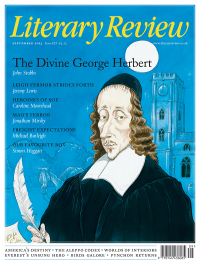Charles Elliott
Beautiful Monster
The Flower of Empire: An Amazonian Water Lily, the Quest to Make It Bloom, and the World It Created
By Tatiana Holway
Oxford University Press 306pp £18.99
It’s a pretty good story. Sometime around 1837 a wandering German émigré named Robert Schomburgk, who had managed to convince the Royal Geographical Society to hire him as an explorer, reported finding an enormous and spectacular species of water lily deep in the Guiana jungle. Of course Schomburgk was not the first European to spot the water lily. As early as 1801 one Thaddäus Haenke discovered it growing near the Bolivia–Paraguay border, but all his collections disappeared when he died in Bolivia in 1817. Subsequently, a French botanist came upon it in the same area and ‘well nigh precipitated himself off the raft into the river … in his desire to secure specimens’. When another Frenchman actually succeeded in collecting leaves, flowers and seeds and shipped them to the National Museum of Natural History in Paris, nobody paid them any attention. They almost completely rotted away. Yet Schomburgk’s timing was sensational: Guiana had only recently become a British possession and there was a new queen on the throne. The country was in a ferment of excitement over botany, with new plants arriving daily, and geography, as new territories were claimed. What better moment to celebrate jointly the glories of the nation and of nature?
The water lily that would bear the queen’s name – Victoria regia – was more than just another plant. Its leaves could grow to a diameter of eight feet with incredible speed (as much as an inch an hour), while its sweet-scented blossoms might exceed a foot in circumference. Its

Sign Up to our newsletter
Receive free articles, highlights from the archive, news, details of prizes, and much more.@Lit_Review
Follow Literary Review on Twitter
Twitter Feed
It wasn’t until 1825 that Pepys’s diary became available for the first time. How it was eventually decrypted and published is a story of subterfuge and duplicity.
Kate Loveman tells the tale.
Kate Loveman - Publishing Pepys
Kate Loveman: Publishing Pepys
literaryreview.co.uk
Arthur Christopher Benson was a pillar of the Edwardian establishment. He was supremely well connected. As his newly published diaries reveal, he was also riotously indiscreet.
Piers Brendon compares Benson’s journals to others from the 20th century.
Piers Brendon - Land of Dopes & Tories
Piers Brendon: Land of Dopes & Tories - The Benson Diaries: Selections from the Diary of Arthur Christopher Benson by Eamon Duffy & Ronald Hyam (edd)
literaryreview.co.uk
Of the siblings Gwen and Augustus John, it is Augustus who has commanded most attention from collectors and connoisseurs.
Was he really the finer artist, asks Tanya Harrod, or is it time Gwen emerged from her brother’s shadow?
Tanya Harrod - Cut from the Same Canvas
Tanya Harrod: Cut from the Same Canvas - Artists, Siblings, Visionaries: The Lives and Loves of Gwen and Augustus John by Judith Mackrell
literaryreview.co.uk